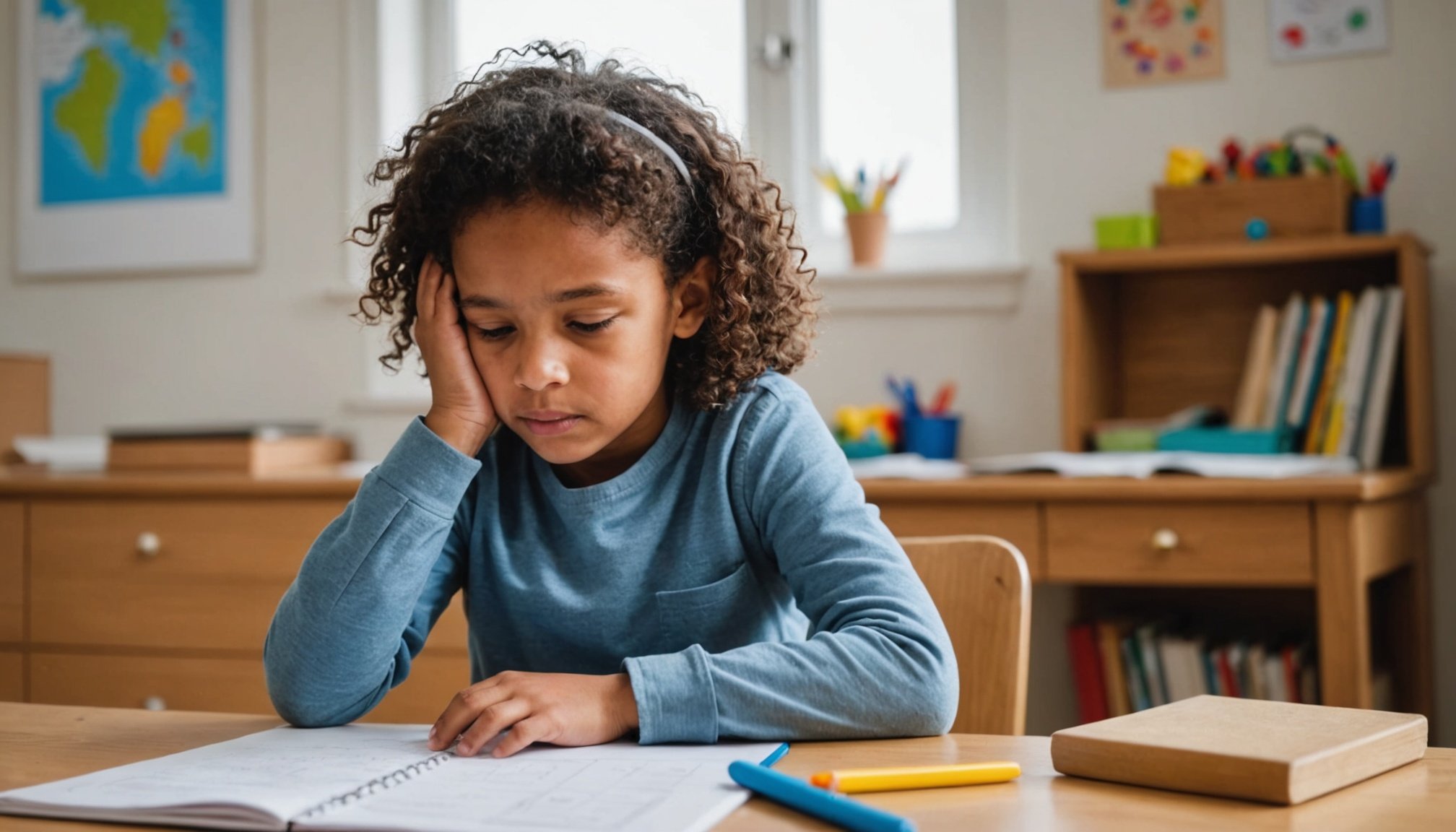Tackling the Rise of Childhood Anxiety: Strategies for UK Pediatricians to Make a Difference
Understanding the Scope of Childhood Anxiety
Childhood anxiety is a growing concern that affects a significant number of young people in the UK. It is essential for pediatricians, parents, and caregivers to understand the scope and impact of anxiety on children’s mental health. According to recent research, the prevalence of anxiety disorders among children and adolescents has been increasing, with studies indicating that up to 1 in 5 children may experience some form of anxiety disorder[3].
Anxiety in children can manifest in various ways, including generalized anxiety, social anxiety, and specific phobias. These disorders can significantly impact a child’s daily life, affecting their ability to learn, interact socially, and maintain good mental health. Dr. Maude Bonenfant, a researcher on game technologies and society, highlights the importance of early intervention: “Les enfants sont encore en apprentissage de l’autorégulation, ils sont impulsifs et pas suffisamment matures pour déceler et comprendre les mécanismes à l’œuvre”[1].
In the same genre : Unlocking Recovery: The Role of UK Neuropsychologists in Stroke Rehabilitation
Identifying Risk Factors and Early Signs
Identifying risk factors and early signs of anxiety is crucial for providing timely support. Here are some key factors and signs to look out for:
Risk Factors:
- Genetic Predisposition: Children with a family history of anxiety disorders are more likely to develop anxiety.
- Environmental Factors: Traumatic events, bullying, and significant changes in the child’s life can trigger anxiety.
- Social Media and Technology: Excessive use of technology, especially during critical developmental periods, can contribute to anxiety and other mental health problems[3].
Early Signs:
- Changes in Behavior: Withdrawal from activities, irritability, or sudden changes in appetite or sleep patterns.
- Physical Symptoms: Headaches, stomachaches, or other physical complaints without a clear medical cause.
- Verbal Cues: Expressions of fear or worry that seem excessive or persistent.
Strategies for Pediatricians to Address Childhood Anxiety
Pediatricians play a vital role in diagnosing and managing childhood anxiety. Here are some strategies they can employ:
Have you seen this : Empowering COPD Management: Innovative Non-Pharmacological Strategies for UK Pulmonologists
Comprehensive Assessment
- Conduct thorough assessments that include both the child and the parents. This can involve questionnaires, behavioral observations, and medical history reviews.
- Use validated screening tools to identify children at risk of anxiety disorders.
Early Intervention
- Cognitive Behavioral Therapy (CBT): This is a highly effective treatment for anxiety disorders in children. CBT helps children identify and change negative thought patterns and behaviors.
- Parental Support: Educate parents on how to create a supportive environment, including techniques to help their child manage anxiety.
Collaboration with Schools
- Work closely with schools to ensure that children receive consistent support across different environments.
- Encourage schools to implement anxiety-reduction programs and provide resources for teachers to recognize and support anxious children.
Table: Comparison of Anxiety Disorders in Children
| Disorder | Symptoms | Impact on Daily Life | Treatment Options |
|---|---|---|---|
| Generalized Anxiety Disorder | Excessive worry about various things, restlessness, difficulty concentrating | Affects school performance, social interactions, and overall well-being | CBT, Medication (if necessary) |
| Social Anxiety Disorder | Fear of social situations, avoidance of social interactions, physical symptoms like blushing or sweating | Limits social engagement, affects relationships and academic performance | CBT, Exposure Therapy |
| Specific Phobias | Intense fear of specific objects or situations | Avoidance behaviors, significant distress | Exposure Therapy, CBT |
The Role of Parents and Caregivers
Parents and caregivers are essential in helping children manage anxiety. Here are some practical tips:
Create a Supportive Environment
- Open Communication: Encourage your child to express their feelings and worries without fear of judgment.
- Consistency and Routine: Establish a daily routine that provides a sense of security and predictability.
Teach Coping Mechanisms
- Deep Breathing Exercises: Teach your child deep breathing techniques to help calm their anxiety.
- Positive Reinforcement: Praise your child for their efforts and accomplishments to boost their confidence.
Seek Professional Help
- If you notice persistent signs of anxiety, do not hesitate to seek help from a pediatrician or a mental health professional.
The Impact of Technology on Child Anxiety
The increased use of technology, especially during the COVID-19 pandemic, has raised concerns about its impact on children’s mental health. Here are some points to consider:
Positive Aspects
- Educational Content: Some apps and games can provide educational content that helps children learn and develop skills.
- Social Connection: Technology can help children stay connected with friends and family, which is crucial for their social and emotional well-being[3].
Negative Aspects
- Excessive Screen Time: Prolonged screen time can lead to increased risk of anxiety, depression, and other mental health issues.
- Addictive Mechanisms: Some games and apps use mechanisms similar to gambling, which can exploit children’s vulnerabilities and lead to addictive behaviors[1].
Community and Social Support
Community and social support are vital for children struggling with anxiety. Here are some ways to foster this support:
School Programs
- Implement school programs that focus on mental health awareness and provide resources for anxious children.
- Encourage schools to have counselors or mental health professionals on staff.
Community Resources
- Support Groups: Organize or participate in support groups for children and their families.
- Local Services: Utilize local health services and mental health organizations that offer counseling and therapy.
Research and Future Directions
Continued research is essential to understanding and addressing childhood anxiety effectively. Here are some areas of focus:
Current Research
- Studies on the impact of technology on children’s mental health are ongoing, highlighting the need for balanced and responsible technology use.
- Research on early intervention strategies, such as CBT and parental support, shows promising results in reducing anxiety in children[3].
Future Directions
- Personalized Interventions: Developing personalized intervention plans based on individual child needs and risk factors.
- Integration with Healthcare Systems: Ensuring that mental health services are integrated into primary healthcare systems to provide seamless support.
Addressing childhood anxiety requires a multifaceted approach that involves pediatricians, parents, schools, and the community. By understanding the risk factors, identifying early signs, and implementing effective strategies, we can make a significant difference in the lives of young people.
As Dr. Maude Bonenfant emphasizes, “Les enfants ne sont pas suffisamment protégés… Il faut adopter des mesures plus strictes pour limiter les effets nocifs de ces jeux vidéo”[1]. This call to action underscores the need for collective responsibility in ensuring the mental health and well-being of our children.
By working together and leveraging the latest research and strategies, we can help children overcome anxiety and thrive in a world filled with challenges and opportunities.











